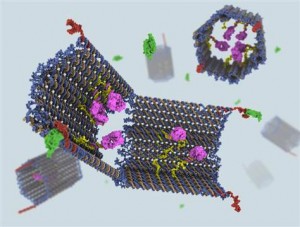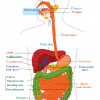What do you get when you cross an immunologist, a nanotechnologist, and a geneticist? A DNA nano-robot!
Welcome to the world of nanobiotechnology and translational research…
In a brilliant example of multidisciplinary research, Harvard Medical School’s Shawn Douglas, Ido Bachelet, and George Church combined forces to build nanostructures that would mimic the body’s immune system to recognize cancer cells and trick them into self-destructing. Their research is published today in Science but the discovery didn’t just happen overnight. It’s the culmination of several key discoveries going back several years, by researchers around the globe.
In 2006, Paul Rothemund at the California Institute of Technology, discovered “DNA origami,” where the Watson-Crick base-pairing rules are exploited to create molecules from viral DNA in specific 3-dimensional shapes. The molecules use small, “staple” strands to bind longer strands and hold them in place. In 2009, chemists and nano-technologists at the Danish National Research Foundation’s Center for DNA Nanotechnology then used DNA origami to create a nano-cube that self-assembled, using staple strands to open a lid.
The Harvard group wondered if there was a way to deliver a nano-cube “robot” to cancer cells and kill them. This is where the immunology expertise paid off: antibodies patrol the bloodstream, honing in on specific cells, binding to them, and signalling them to self-destruct. So how can a DNA nano-robot deliver antibodies to the surface of cancer cells? Remember the cube’s lid?
“We could actually make an open-ended container and then all it would need to do is just turn itself inside out,” Douglas said.
They created a “nano-clam” with antibodies waiting inside, ready to launch their attack. The nano-clam springs open when one of the staple strands is broken, just like turning a key in a lock.
And the really clever thing? The lock can be designed so that the key is in the shape of certain cancer cells. So when the cube encounters a cancer cell, such as lymphoma or leukemia cells, it springs open, exposing antibody fragments to the surface of the cell in a “surgical strike.” Unlike chemotherapy, which doesn’t discriminate between cell types, these DNA nano-robots only strike down cancer cells, leaving good cells alone.
The beauty of this discovery is that the underlying mechanism can be adapted for different diseases, by using different combinations of locks and antibodies. As the Danish chemist Kurt Gothelf commented, “People have been talking a lot about robots that enter your body, and go to a place where something is wrong and fix it. This is the first example that this might come true one day.”
The next step is to work out scalability. The current research was in Petri dishes in the lab, with 100 billion copies of the robot, but trillions are required for animals and humans. And the robot needs to become more robust to travel through the bloodstream, rather than through a pipette. Our body is very adept at getting rid of foreign bodies so they have to figure out a way for the nano-clams to swim “under the radar.”
Watch this space…
| Print article | This entry was posted by Amy Nisselle on February 17, 2012 at 12:18 pm, and is filed under Inside Cancer. Follow any responses to this post through RSS 2.0. You can leave a response or trackback from your own site. |











